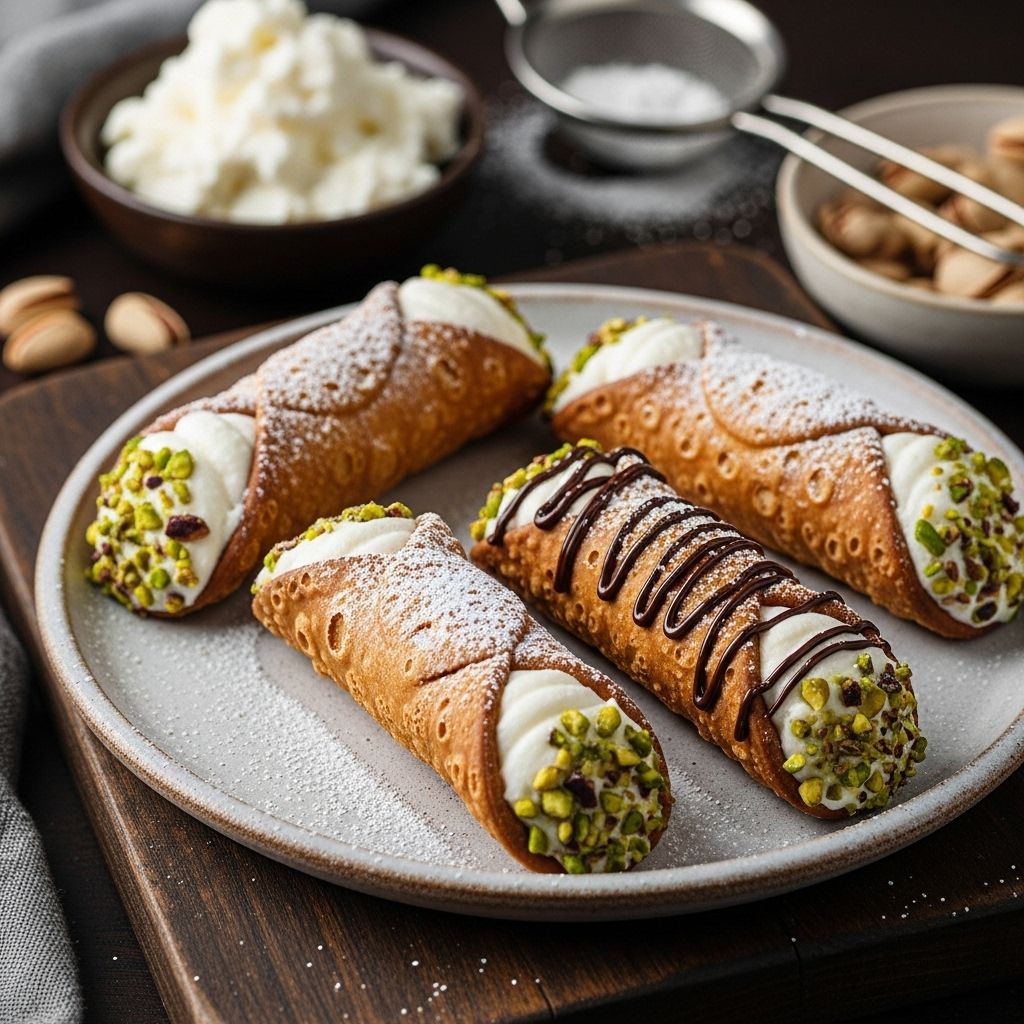Homemade Cannoli Recipe: Authentic Step-By-Step Guide
Master the art of creating authentic Sicilian cannoli with crispy shells and creamy ricotta filling

Image: HearthJunction Design Team
Classic Homemade Cannoli: Authentic Italian Pastry
Cannoli are one of Italy’s most beloved desserts, originating from Sicily and now enjoyed worldwide. These crispy, tube-shaped pastry shells filled with sweetened ricotta cheese create the perfect balance of textures and flavors. While they might seem intimidating to make at home, with the right guidance, you can create restaurant-quality cannoli in your own kitchen. This comprehensive recipe will guide you through each step of creating authentic Italian cannoli from scratch.
What Are Cannoli?
Cannoli (singular: cannolo) are traditional Sicilian pastries consisting of tube-shaped shells of fried pastry dough filled with a sweet, creamy filling usually containing ricotta cheese. The name comes from the Italian word ‘canna,’ meaning reed or cane, as traditionally, the pastry was formed by wrapping the dough around sugar cane stalks before frying. These delightful treats have a rich history dating back to the Arab rule of Sicily, making them not just delicious but culturally significant as well.
Today, cannoli are popular throughout Italy and in Italian-American communities. They’re characterized by their distinctive crispy shell and rich, sweet filling, often garnished with ingredients like chopped pistachios, chocolate chips, candied fruit, or a dusting of powdered sugar.
Ingredients You’ll Need
For the Cannoli Shells:
- 3 cups all-purpose flour
- 1/4 cup white sugar
- 1/4 teaspoon salt
- 3 tablespoons shortening
- 1/2 cup sweet Marsala wine
- 2 tablespoons water
- 1 tablespoon distilled white vinegar
- 1 large egg
- 1 egg yolk (save the white for sealing)
- 1 quart oil for frying (canola or vegetable oil)
For the Ricotta Filling:
- 2 pounds ricotta cheese, drained
- 1 cup confectioners’ sugar
- 1/4 teaspoon ground cinnamon
- 1/4 cup mini chocolate chips or finely chopped chocolate
- 1/4 cup candied citron or orange peel (optional)
Additional Items Needed:
- Cannoli tubes or forms (metal or wooden)
- Pasta machine or rolling pin
- Deep-fry thermometer
- Pastry bag with a large round tip
- Additional confectioners’ sugar for dusting
- Chopped pistachios, additional chocolate chips, or candied fruit for garnish (optional)
Step-by-Step Instructions
Preparing the Cannoli Shell Dough
The shell is what gives cannoli their distinctive crunch and serves as the perfect vessel for the creamy filling. Creating the right dough texture is crucial for achieving that characteristic bubbly, crispy exterior.
- Mix dry ingredients: In a large bowl, combine the flour, sugar, and salt, whisking thoroughly to ensure even distribution.
- Cut in shortening: Using a pastry cutter or your fingertips, work the shortening into the flour mixture until it resembles coarse crumbs. The texture should be sandy with no visible large chunks of shortening.
- Create a well: Make a well in the center of the flour mixture for adding your wet ingredients.
- Add wet ingredients: Pour the Marsala wine, water, vinegar, egg, and egg yolk into the well.
- Form the dough: Gradually incorporate the flour into the liquid, starting from the center and working outward. Mix until a dough forms, being careful not to overmix.
- Knead the dough: Turn the dough onto a lightly floured surface and knead for about 5 minutes until smooth and elastic.
- Rest the dough: Shape the dough into a ball, wrap it in plastic wrap, and refrigerate for at least 1 hour or up to 24 hours. This resting period allows the gluten to relax, making the dough easier to roll thin.
Rolling and Cutting the Dough
Achieving the perfect thickness for cannoli shells is essential. They need to be thin enough to become crispy when fried but sturdy enough to hold the filling without breaking.
- Divide the dough: After resting, divide the dough into 4 equal portions to make it more manageable.
- Roll the dough: Using a pasta machine or rolling pin, roll one portion at a time, keeping the others covered to prevent drying. If using a pasta machine, start at the widest setting and gradually work to the thinnest setting. If using a rolling pin, aim for about 1/16-inch thickness (paper-thin).
- Cut circles: Using a 4-inch round cookie cutter or glass, cut circles from the rolled dough. Re-roll scraps to use all the dough.
- Prepare for wrapping: Lightly beat the reserved egg white in a small bowl. This will be used as a seal for the cannoli shapes.
- Shape the shells: Place a cannoli tube or form diagonally across each dough circle. Fold the dough up and around the tube, with the edges overlapping.
- Seal the edges: Apply a small amount of egg white to the overlapping edge and press firmly to seal. Ensure it’s well-sealed to prevent opening during frying.
Frying the Cannoli Shells
Properly frying the shells is crucial for achieving that signature crispness that contrasts so wonderfully with the creamy filling.
- Heat the oil: In a deep, heavy-bottomed pot or deep fryer, heat the oil to 375°F (190°C). Use a thermometer to maintain this temperature throughout frying.
- Prepare for frying: Line a plate with paper towels for draining the fried shells.
- Fry the shells: Carefully lower 2-3 shell-wrapped tubes into the hot oil, being careful not to crowd the pot. Fry for 2-3 minutes, turning occasionally with tongs, until the shells are golden brown and blistered.
- Drain and cool: Remove the shells with tongs and place them on the paper towel-lined plate to drain excess oil.
- Remove the tubes: When the shells are cool enough to handle (but still warm), carefully slide them off the tubes. Be gentle to avoid breaking them.
- Continue frying: Repeat with the remaining dough circles, allowing the oil to return to 375°F between batches.
- Cool completely: Allow the shells to cool fully on a wire rack before filling. This ensures they maintain their crispness.
Preparing the Ricotta Filling
The creamy, sweet ricotta filling is the heart of any good cannoli. Properly draining the ricotta prevents a watery filling, ensuring the perfect consistency.
- Drain the ricotta: For best results, drain the ricotta overnight in the refrigerator using a fine-mesh strainer lined with cheesecloth. This removes excess moisture and creates a thicker, creamier filling.
- Mix the filling: In a large bowl, combine the drained ricotta, confectioners’ sugar, and ground cinnamon. Beat until smooth and well combined.
- Add mix-ins: Gently fold in the mini chocolate chips and candied citron or orange peel (if using). Be careful not to overmix.
- Chill the filling: Cover the filling and refrigerate for at least 1 hour to allow the flavors to meld and the filling to firm up slightly.
Filling and Serving the Cannoli
The final assembly should be done just before serving to ensure the shells remain crispy and the presentation is at its best.
- Prepare for filling: Transfer the chilled ricotta filling to a pastry bag fitted with a large round tip.
- Fill the shells: Pipe the filling into each end of the cannoli shells, making sure to fill them completely from end to end.
- Garnish: Dip the exposed filling at each end into chopped pistachios, mini chocolate chips, or candied fruit if desired.
- Final touch: Dust the filled cannoli lightly with confectioners’ sugar just before serving.
- Serve: Arrange on a serving platter and enjoy immediately for the best texture contrast between the crispy shell and creamy filling.
Storage and Make-Ahead Tips
Understanding how to properly store cannoli components ensures you can prepare elements in advance without compromising on quality.
- Unfilled shells: Store in an airtight container at room temperature for up to 1 week.
- Filling: Refrigerate in an airtight container for up to 2 days.
- Filled cannoli: Best enjoyed within 1-2 hours of filling. The moisture from the filling will eventually soften the crispy shells.
- Dough: Can be made up to 2 days ahead and stored wrapped in plastic in the refrigerator.
Recipe Variations and Customizations
While traditional cannoli are delicious, there are many ways to put your own spin on this classic dessert.
Shell Variations:
- Chocolate shells: Add 2 tablespoons of cocoa powder to the dry ingredients for chocolate cannoli shells.
- Cinnamon shells: Add 1 teaspoon of ground cinnamon to the dry ingredients.
- Coffee-infused: Replace the water with strong espresso for a subtle coffee flavor.
Filling Variations:
- Chocolate ricotta: Add 2-3 tablespoons of cocoa powder to the filling for a chocolate version.
- Flavor infusions: Add different extracts like almond, orange, or lemon to customize the flavor profile.
- Mascarpone blend: Replace half the ricotta with mascarpone cheese for an even creamier texture.
- Whipped cream blend: Fold in 1/2 cup of whipped cream for a lighter texture.
Frequently Asked Questions (FAQs)
Q: Why is my cannoli filling runny?
A: The most common reason is not draining the ricotta properly. Always drain ricotta overnight in the refrigerator using a cheesecloth-lined strainer to remove excess moisture. Additionally, make sure all ingredients are cold when mixing the filling.
Q: Can I make cannoli without cannoli tubes?
A: Yes, though traditional tubes give the best results. In a pinch, you can use aluminum foil formed into a tube shape, wooden dowels cut to size, or even metal cookie cutters carefully wrapped with the dough.
Q: Why did my cannoli shells bubble and blister during frying?
A: This is actually desirable! The bubbles and blisters create the characteristic texture of authentic cannoli shells. They’re caused by moisture in the dough turning to steam during frying.
Q: Can I bake the shells instead of frying them?
A: While traditionally fried, you can bake the shells at 375°F (190°C) for about 15 minutes until golden. Note that baked shells won’t have quite the same texture as fried ones, but they’re still delicious and a bit healthier.
Q: Why did my shells crack when I tried to remove them from the tubes?
A: The shells may have been too thin or removed before cooling slightly. Wait until the shells are warm but not hot before attempting to remove them. Slide them off gently rather than pulling.
Tips for Perfect Cannoli Every Time
- Keep the dough chilled until ready to roll out
- Roll the dough as thin as possible without tearing
- Maintain the oil at a consistent temperature while frying
- Fill cannoli just before serving to maintain shell crispness
- Use high-quality ricotta and drain it thoroughly for the best filling texture
- Let the shells cool completely before storing to prevent moisture buildup
- If using Marsala wine isn’t an option, sweet white wine can be substituted
Making cannoli at home is a labor of love, but the results are well worth the effort. These iconic Italian pastries bring a touch of Sicily to your table and are sure to impress family and friends. With practice, you’ll develop the techniques needed to create perfect cannoli every time, perhaps even adding your own signature twist to this classic dessert.
References
Read full bio of Anjali Sayee












